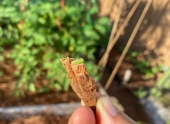
 6
6




![Filename: pipevine-butterfly.jpg
Description: Pipevine Butterfly [Thumbnail for pipevine-butterfly.jpg]](/t/59499/a/44310/pipevine-butterfly.jpg)
![Filename: Hornworm.jpg
Description: Tomato Hornworm [Thumbnail for Hornworm.jpg]](/t/59499/a/44312/Hornworm.jpg)
Invasive plants are Earth's way of insisting we notice her medicines. Stephen Herrod Buhner
Everyone learns what works by learning what doesn't work. Stephen Herrod Buhner
 5
5




 6
6




Idle dreamer
 5
5




Tyler Ludens wrote:The Devil's Claw plant, Proboscidea species, native to the south and western parts of North America, is the only non-tomato relative on which Sphinx Moth larvae will feed. It is a large, beautiful plant and I grow it specifically for the Sphinx Moths. If I find a tomato worm on my tomatoes, I just move her over to the Devil's Claw.
Invasive plants are Earth's way of insisting we notice her medicines. Stephen Herrod Buhner
Everyone learns what works by learning what doesn't work. Stephen Herrod Buhner
 6
6




Idle dreamer
 4
4




Invasive plants are Earth's way of insisting we notice her medicines. Stephen Herrod Buhner
Everyone learns what works by learning what doesn't work. Stephen Herrod Buhner
 4
4




Invasive plants are Earth's way of insisting we notice her medicines. Stephen Herrod Buhner
Everyone learns what works by learning what doesn't work. Stephen Herrod Buhner
 4
4




 3
3




![Filename: dancing-broccoli-23.gif
Description: [Thumbnail for dancing-broccoli-23.gif]](/t/59499/a/51014/dancing-broccoli-23.gif)
The real world is bizarre enough for me...Blue Oyster Cult
 3
3




Invasive plants are Earth's way of insisting we notice her medicines. Stephen Herrod Buhner
Everyone learns what works by learning what doesn't work. Stephen Herrod Buhner
 2
2




Invasive plants are Earth's way of insisting we notice her medicines. Stephen Herrod Buhner
Everyone learns what works by learning what doesn't work. Stephen Herrod Buhner
 2
2







Invasive plants are Earth's way of insisting we notice her medicines. Stephen Herrod Buhner
Everyone learns what works by learning what doesn't work. Stephen Herrod Buhner
 2
2




Invasive plants are Earth's way of insisting we notice her medicines. Stephen Herrod Buhner
Everyone learns what works by learning what doesn't work. Stephen Herrod Buhner

|
Bring out your dead! Or a tiny ad:
The new gardening playing cards kickstarter is now live!
https://www.kickstarter.com/projects/paulwheaton/garden-cards
|






